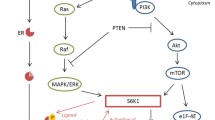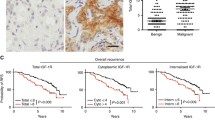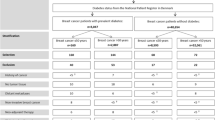Abstract
Insulin receptor substrate-1 (IRS-1) is a cytoplasmic scaffolding protein that is phosphorylated by insulin-like growth factor-I receptor and recruits downstream effectors. Recent evidence suggests that IRS-1 has a nuclear localization and function. Here we investigated whether nuclear and cytoplasmic IRS-1 levels are associated with clinico-pathological characteristics and clinical outcome in breast cancer patients. Tissue microarrays from 1,097 patients with stage I–II breast cancer were stained by immunohistochemistry for IRS-1. Nuclear and cytoplasmic IRS-1 were scored separately according to the Allred score. Nuclear IRS-1 showed a positive association with estrogen receptor (ER) (r = 0.09, P = 0.003) and progesterone receptor (PR) (r = 0.08, P = 0.008) status and a negative correlation with lymph node involvement (r = −0.10, P = 0.001). Cytoplasmic IRS-1 did not correlate with ER or PR but showed a positive correlation with tumor size (r = 0.10, P = 0.001) and S-phase fraction (r = 0.16, P < 0.001). In univariate analysis, tamoxifen-treated patients with tumors showing positive nuclear IRS-1 had a better recurrence-free survival (RFS) (P = 0.009) and overall survival (OS) (P = 0.0007), while no association was shown between cytoplasmic IRS-1 and RFS or OS in the same group of patients. In multivariate analysis of patients receiving tamoxifen, negative nuclear IRS-1 showed a significantly reduced RFS (P = 0.046) and OS (P = 0.018). Combining both PR and nuclear IRS-1, tamoxifen-treated patients with PR+/IRS-1+ tumors had a better RFS (P = 0.0003) and OS (P < 0.0001) when compared with patients with PR−/IRS-1− tumors. In conclusion, nuclear IRS-1 may be a useful marker to predict tamoxifen response in patients with early breast cancer, particularly when assessed in combination with PR.



Similar content being viewed by others
References
Osborne CK (1998) Tamoxifen in the treatment of breast cancer. N Engl J Med 339(22):1609–1618
Cui X, Schiff R, Arpino G, Osborne CK, Lee AV (2005) Biology of progesterone receptor loss in breast cancer and its implications for endocrine therapy. J Clin Oncol 23(30):7721–7735
Knowlden JM, Jones HE, Barrow D, Gee JM, Nicholson RI, Hutcheson IR (2008) Insulin receptor substrate-1 involvement in epidermal growth factor receptor and insulin-like growth factor receptor signalling: implication for Gefitinib (‘Iressa’) response and resistance. Breast Cancer Res Treat 111(1):79–91
Dearth RK, Cui X, Kim HJ, Hadsell DL, Lee AV (2007) Oncogenic transformation by the signaling adaptor proteins insulin receptor substrate (IRS)-1 and IRS-2. Cell Cycle 6(6):705–713
Jackson JG, White MF, Yee D (1998) Insulin receptor substrate-1 is the predominant signaling molecule activated by insulin-like growth factor-I, insulin, and interleukin-4 in estrogen receptor-positive human breast cancer cells. J Biol Chem 273(16):9994–10003
Nolan MK, Jankowska L, Prisco M, Xu S, Guvakova MA, Surmacz E (1997) Differential roles of IRS-1 and SHC signaling pathways in breast cancer cells. Int J Cancer 72(5):828–834
Surmacz E (2000) Function of the IGF-I receptor in breast cancer. J Mammary Gland Biol Neoplasia 5(1):95–105
Surmacz E, Burgaud JL (1995) Overexpression of insulin receptor substrate 1 (IRS-1) in the human breast cancer cell line MCF-7 induces loss of estrogen requirements for growth and transformation. Clin Cancer Res 1(11):1429–1436
Morelli C, Garofalo C, Bartucci M, Surmacz E (2003) Estrogen receptor-alpha regulates the degradation of insulin receptor substrates 1 and 2 in breast cancer cells. Oncogene 22(26):4007–4016
Lee AV, Jackson JG, Gooch JL, Hilsenbeck SG, Coronado-Heinsohn E, Osborne CK, Yee D (1999) Enhancement of insulin-like growth factor signaling in human breast cancer: estrogen regulation of insulin receptor substrate-1 expression in vitro and in vivo. Mol Endocrinol 13(5):787–796
Mauro L, Salerno M, Panno ML, Bellizzi D, Sisci D, Miglietta A, Surmacz E, Ando S (2001) Estradiol increases IRS-1 gene expression and insulin signaling in breast cancer cells. Biochem Biophys Res Commun 288(3):685–689
Molloy CA, May FE, Westley BR (2000) Insulin receptor substrate-1 expression is regulated by estrogen in the MCF-7 human breast cancer cell line. J Biol Chem 275(17):12565–12571
Cesarone G, Garofalo C, Abrams MT, Igoucheva O, Alexeev V, Yoon K, Surmacz E, Wickstrom E (2006) RNAi-mediated silencing of insulin receptor substrate 1 (IRS-1) enhances tamoxifen-induced cell death in MCF-7 breast cancer cells. J Cell Biochem 98(2):440–450
Guvakova MA, Surmacz E (1997) Overexpressed IGF-I receptors reduce estrogen growth requirements, enhance survival, and promote E-cadherin-mediated cell-cell adhesion in human breast cancer cells. Exp Cell Res 231(1):149–162
Salerno M, Sisci D, Mauro L, Guvakova MA, Ando S, Surmacz E (1999) Insulin receptor substrate 1 is a target for the pure antiestrogen ICI 182, 780 in breast cancer cells. Int J Cancer 81(2):299–304
Wu A, Chen J, Baserga R (2008) Nuclear insulin receptor substrate-1 activates promoters of cell cycle progression genes. Oncogene 27(3):397–403
Morelli C, Garofalo C, Sisci D, del Rincon S, Cascio S, Tu X, Vecchione A, Sauter ER, Miller WH Jr, Surmacz E (2004) Nuclear insulin receptor substrate 1 interacts with estrogen receptor alpha at ERE promoters. Oncogene 23(45):7517–7526
Sisci D, Morelli C, Cascio S, Lanzino M, Garofalo C, Reiss K, Garcia M, Russo A, Ando S, Surmacz E (2007) The estrogen receptor alpha:insulin receptor substrate 1 complex in breast cancer: structure-function relationships. Ann Oncol 18(Suppl 6):vi81–vi85
Ma Z, Gibson SL, Byrne MA, Zhang J, White MF, Shaw LM (2006) Suppression of insulin receptor substrate 1 (IRS-1) promotes mammary tumor metastasis. Mol Cell Biol 26(24):9338–9351
Koda M, Sulkowska M, Kanczuga-Koda L, Sulkowski S (2005) Expression of insulin receptor substrate 1 in primary breast cancer and lymph node metastases. J Clin Pathol 58(6):645–649
Rocha RL, Hilsenbeck SG, Jackson JG, VanDenBerg CL, Weng C, Lee AV, Yee D (1997) Insulin-like growth factor binding protein-3 and insulin receptor substrate-1 in breast cancer: correlation with clinical parameters and disease-free survival. Clin Cancer Res 3(1):103–109
Schnarr B, Strunz K, Ohsam J, Benner A, Wacker J, Mayer D (2000) Down-regulation of insulin-like growth factor-I receptor and insulin receptor substrate-1 expression in advanced human breast cancer. Int J Cancer 89(6):506–513
Sisci D, Morelli C, Garofalo C, Romeo F, Morabito L, Casaburi F, Middea E, Cascio S, Brunelli E, Ando S et al (2007) Expression of nuclear insulin receptor substrate 1 in breast cancer. J Clin Pathol 60(6):633–641
Allred DC, Clark GM, Tandon AK, McGuire WL (1993) Immunohistochemistry on histological sections from small (50 mg) samples of pulverized breast cancer. J Histotech 16(2):117–120
Mohsin SK, Weiss H, Havighurst T, Clark GM, Berardo M, le Roanh D, To TV, Qian Z, Love RR, Allred DC (2004) Progesterone receptor by immunohistochemistry and clinical outcome in breast cancer: a validation study. Mod Pathol 17(12):1545–1554
Harvey JM, Clark GM, Osborne CK, Allred DC (1999) Estrogen receptor status by immunohistochemistry is superior to the ligand-binding assay for predicting response to adjuvant endocrine therapy in breast cancer. J Clin Oncol 17(5):1474–1481
Lee AV, Zhang P, Ivanova M, Bonnette S, Oesterreich S, Rosen JM, Grimm S, Hovey RC, Vonderhaar BK, Kahn CR et al (2003) Developmental and hormonal signals dramatically alter the localization and abundance of insulin receptor substrate proteins in the mammary gland. Endocrinology 144(6):2683–2694
Tu X, Batta P, Innocent N, Prisco M, Casaburi I, Belletti B, Baserga R (2002) Nuclear translocation of insulin receptor substrate-1 by oncogenes and Igf-I. Effect on ribosomal RNA synthesis. J Biol Chem 277(46):44357–44365
Allred DC, Harvey JM, Berardo M, Clark GM (1998) Prognostic and predictive factors in breast cancer by immunohistochemical analysis. Mod Pathol 11(2):155–168
Arpino G, Weiss H, Lee AV, Schiff R, De Placido S, Osborne CK, Elledge RM (2005) Estrogen receptor-positive, progesterone receptor-negative breast cancer: association with growth factor receptor expression and tamoxifen resistance. J Natl Cancer Inst 97(17):1254–1261
Bardou VJ, Arpino G, Elledge RM, Osborne CK, Clark GM (2003) Progesterone receptor status significantly improves outcome prediction over estrogen receptor status alone for adjuvant endocrine therapy in two large breast cancer databases. J Clin Oncol 21(10):1973–1979
Acknowledgments
This project was supported in part by funding from Susan G Komen for the Cure (A.V.L.), and supported by NIH P50CA58183 (C.K.O) from the National Cancer Institute. Its contents are solely the responsibility of the authors and do not necessarily represent the official views of the Susan G. Komen for the Cure, the National Cancer Institute, or the National Institutes of Health.
Author information
Authors and Affiliations
Corresponding author
Rights and permissions
About this article
Cite this article
Migliaccio, I., Wu, MF., Gutierrez, C. et al. Nuclear IRS-1 predicts tamoxifen response in patients with early breast cancer. Breast Cancer Res Treat 123, 651–660 (2010). https://doi.org/10.1007/s10549-009-0632-6
Received:
Accepted:
Published:
Issue Date:
DOI: https://doi.org/10.1007/s10549-009-0632-6




